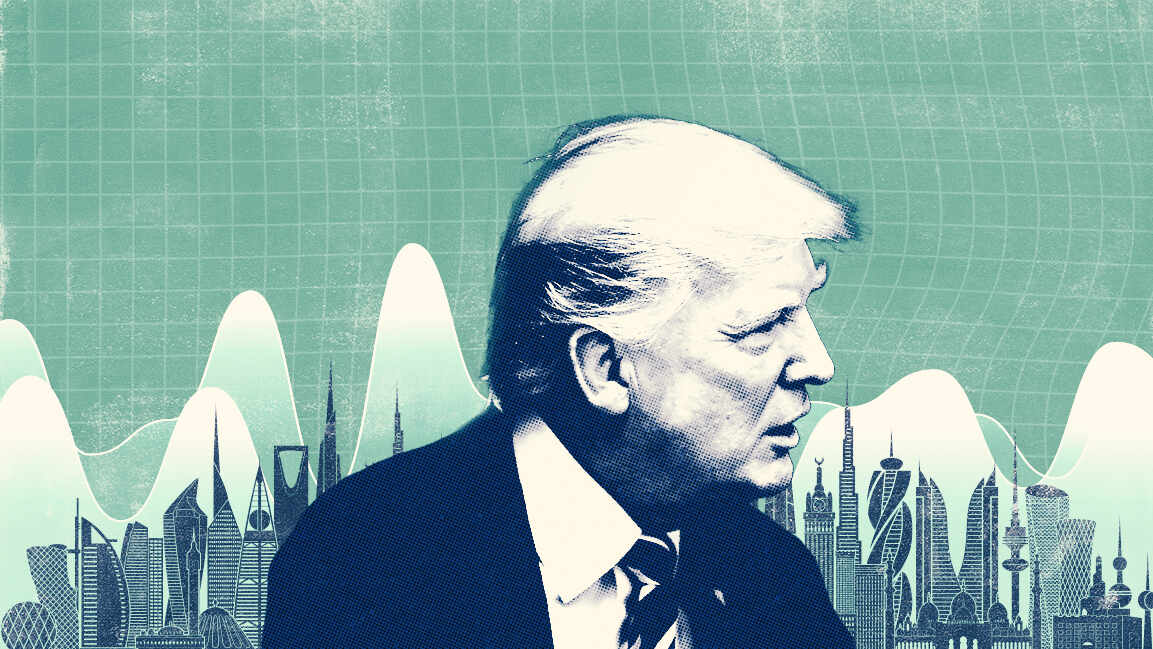- | 9:00 am
What does President Trump’s GCC visit this week mean for the region?
Gulf nations’ trillion-dollar relationship with the US could bring closer trade ties – but tariffs look set to stay

US President Donald Trump’s visit to the Middle East tomorrow could help drive efforts to diversify the region’s hydrocarbon-rich economies. The trip, which is expected to include major commercial and defence agreements, will also reaffirm the traditional energy ties that have defined the relationship between the US and its Gulf allies.
“Businesses expect the US to continue to leverage its relationships with GCC states against China. This administration also wants to expand economic and energy ties with Middle Eastern allies,” says Raj Desai, Co-Academic Director of the Master of Arts in International Business and Policy at Georgetown University Dubai. “In addition to energy, industries set to gain include defense, financial services, and advanced technology.”
He says this could boost the non-hydrocarbon economy in the GCC, facilitate greater technology transfer, and most critically, create jobs in the non-governmental sector.
DOLLAR DEAL ANNOUNCEMENTS
Closer ties will undoubtedly be the focus of the state visit, with local media quoting US state officials as readying for dollar deal announcements in the UAE, Saudi Arabia, and potentially Qatar.
In Saudi Arabia, the US will seal an arms deal worth more than $100 billion. Earlier this year, the kingdom said it would spend $600 billion to expand trade and investment with the US over the next four years, but the details remain undisclosed. Civil nuclear cooperation talks are also ahead and are part of Riyadh’s diversification agenda.
The UAE has pledged $1.4 trillion in US investments, targeting AI infrastructure, semiconductors, energy, and manufacturing over the next decade. The plan includes a new Emirates Global Aluminium smelter plant, which would nearly double the US metal production.
The UAE is the largest US export market in the region, with $34.4 billion in exports in 2024. According to the UAE embassy in Washington, DC, the two nations already share a $1 trillion economic partnership. Total trade between Saudi Arabia and the US was approximately $25.9 billion in 2024.
“The visit highlights the importance of Saudi Arabia, Qatar, and the UAE as regional powerhouses with deep pockets that invest significantly in the US economy,” says Hamza Dweik, Head of Trading and Pricing (MENA), Saxo Bank.“Strengthening relationships with Gulf leaders amid regional crises and economic problems at home in the US could lead to more stable economic conditions.”
More retail investment may flow into the US after the visit, as felt by Elie Khouri, founder of the Dubai-based family office Vivium and chairman of Omnicom Media Group MENA. “President Trump’s visit may reinforce real estate flows from the GCC into the US, but this will depend on oil prices. Lower prices lead to budget deficits, typically reducing the Gulf’s appetite for global investments. The Trump Organization’s newly announced projects in the UAE and Qatar, such as a luxury golf resort and tower, signal strong regional interest in partnerships with the US.”
QUESTIONS ABOUT TARIFFS
Recently, the International Monetary Fund has reduced its US growth forecast by 0.9 percentage points to 1.8% in 2025 and trimmed global GDP growth forecasts to 2.8%. The downgrades follow policy uncertainty after President Trump announced and then paused new trade tariffs to seek more favourable terms from partner nations. Gulf nations face a 10% tariff increase, with exemptions on oil and small non-oil exports.
“Discussions during the visit may focus on adjusting these tariffs to foster better trade relations and reduce economic tensions,” Dweik says.
He adds that the visit could boost prospects for three sectors: Gulf oil producers may benefit from stable prices and renewed demand, while investor interest in gold and copper is rising. Finally, strategic sectors like AI, semiconductors, and renewables may attract increased policy-driven investment.
Dave Goodger, managing director of EMEA at the Oxford Economics company Tourism Economics, says tariff reductions are unlikely. “We aren’t expecting any real movement in the tariffs since GCC countries are already on the minimum 10% rate, and hydrocarbon exports are exempt from this. Gulf businesses have limited exposure to the tariffs at present,” he says. “However, some special dispensation or new agreement may be mentioned, given some planned bilateral investments. There has been some discussion about changes to tariffs on chip production, but this still remains uncertain.”
REWIRING GCC ECONOMIES
The tour of the Gulf comes at a time of evolving trade strategies and economic reforms in the region. As the world’s largest economy, its GDP is as large as the next three. US policies have a significant global influence. The GCC also feels the impact of US monetary policy thanks to its currencies’ dollar peg.
Gulf states, particularly the UAE and Saudi Arabia, have made concerted and sustained efforts to “rewire” their economies, diversifying away from hydrocarbons into sectors such as defence, technology, and logistics, says Dr Neil Quilliam, Associate Fellow, Middle East & North Africa Programme at the Chatham House policy institute.
That pivot includes the UAE and Saudi Arabia, which have also been invited to join the BRICS+ international grouping. The group is exploring a common currency to reduce global trade reliance on the US dollar.
President Trump’s policies won’t reverse that shift, Dr. Quilliam says. “Given the progress they have made, they are unlikely to change strategy based on a four-year term of a Trump presidency,” he says. “Having said that, on a recent visit by HH Sheikh Tahnoon bin Zayed Al Nahyan to Washington DC, he underscored the UAE’s ambition to establish itself as a leading technological power while deepening its alignment with the US in the context of escalating US-China tensions.”
On the other hand, the tariffs could also push GCC exporters in sectors such as petrochemicals, aluminium, and fertilizers to widen export markets, including by targeting Asia and Africa. Dr. Quilliam says GCC sovereign wealth funds and trade ministries will likely hedge against US volatility by seeking preferential trade agreements with the EU, China, and India.
Overall, there is also a view that the visit could enhance the GCC nations’ role as mediators in international affairs.
In February, Saudi Arabia hosted talks between the US and Russia aimed at ending the war in Ukraine.
“The role of Gulf states as brokers and facilitators in regional conflicts and crises could be reinforced, potentially unlocking new economic opportunities,” Dweik says.






































